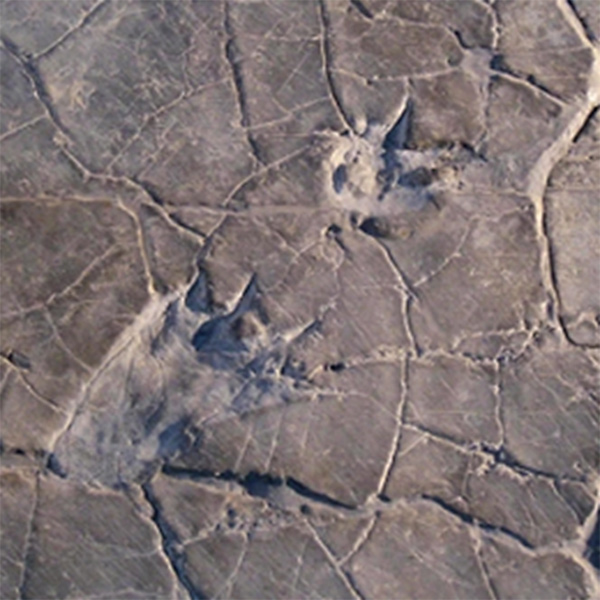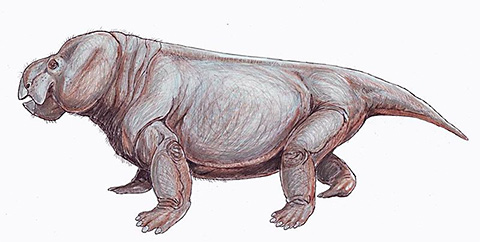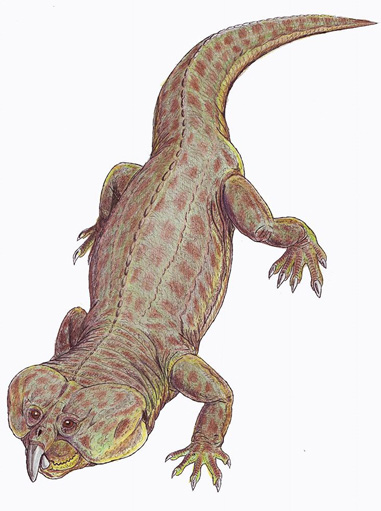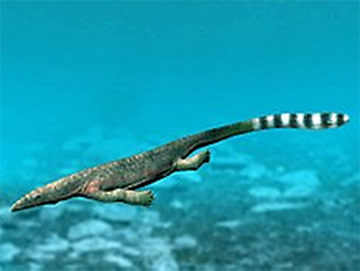
Mass extinctions have happened throughout Earth’s history, sometimes wiping out the large majority of all life on Earth.
Each spelled the end for millions of species—and the beginning for millions more that evolved to take their places.
On earlier EarthDates, we talked about the asteroid that smashed into Earth, ending the reign of the dinosaurs while opening the door for mammals.
But there was an earlier event that appears to have created the same opening for dinosaurs themselves.
Around 250 million years ago, dinosaurs made up only about 5 percent of animals on Earth.
Then a massive series of volcanic eruptions filled the atmosphere with carbon dioxide, which triggered dramatic global warming and extreme global rainfall.
The rain caused floods across the planet for many thousands of years. Floods alternated with periods of drought for 1 to 2 million years, to create an era so severe it earned its own geologic name: The Carnian Pluvial Episode.
It stressed all life on Earth, plants and animals, and removed many species that were poorly equipped for the harsh conditions.
By 2 million years after the Pluvial Episode, dinosaurs, who were better adapted for these conditions, exploded in population and variety, with new species filling empty environmental niches.
What happened for the dinosaurs, then happened to the dinosaurs—and it will happen again. In this way, life on Earth renews itself.
Background
Synopsis: The nonavian dinosaurs went out with a bang in a global extinction event that occurred when the Chicxulub meteorite crashed into Earth about 66 million years ago, abandoning niches that mammals then diversified to fill. But dinosaurs themselves got a very similar start on diversification and global domination during extinction events that began 232 million years ago in the Carnian Pluvial Episode during the Triassic Period.
- The Triassic Period was one of the cruelest times for life on Earth.

Kannemeyeriiform dicynodonts were herbivores from the Middle Triassic of Brazil that did not survive the Carnian Pluvial Episode, making way for dinosaurs to fill their evolutionary niche. Credit: Dmitry Bogdanov [CC BY-SA 3.0 (https://creativecommons.org/licenses/by-sa/3.0)] - The Triassic—and the Mesozoic Era—started 252 million years ago when all the continents were assembled into the giant landmass of Pangaea, which soon began to break apart along the mid-Atlantic Ridge to form the Atlantic Ocean.
- Just before the Triassic Period started, the Paleozoic Era ended with the apocalyptic “Great Dying” event—an extinction tied to volcanic eruptions in what is now Siberia that caused intense global warming, wiping out 96 percent of all living species and leaving a blank slate for the evolution of life.
- The Triassic saw the rise of dinosaurs, crocodilians, conifers, corals, plankton and the earliest mammals.
- In many places, Triassic rocks are obvious as deep reddish outcrops characterized by oxidized iron staining.
- About 50 million years after it started, the Triassic Period ended with another mass extinction that extinguished about 75 percent of Earth’s species in just 10,000 years. But the dinosaurs survived and thrived through that extinction, dominating the food chain for another 140 million years.
- Earth’s earliest dinosaur fossils are found in Tanzania and are about 243 million years old.
- Confined to the southern reaches of Pangaea, early dinosaurs were a rare, obscure group of animals.
- Even 10 million years later, fossil proportions suggest they made up just 5% of land animals.
- About 234 million years ago, massive volcanic eruptions began on the other side of Pangaea that produced the Wrangellia basalts, now exposed in western Canada and Alaska.

Widespread across Pangaea, herbivorous Hyperodapedon rhynchosaurs may have died out in the Carnian floods because of extinction of their food sources. Credit: DiBgd [CC BY 3.0 (https://creativecommons.org/licenses/by/3.0)] - These eruptions belched carbon dioxide into the atmosphere, driving global warming, ocean acidification and extreme global rainfall.
- The cataclysmic monsoons were so intense that the period has its own geological name: The Carnian Pluvial Episode.
- Evidence from marine sediments reflects the composition of ancient seawater, including information about temperature, rainfall and carbon dioxide.
- Four distinct humid-to-arid pulses occurred over a period of 1 to 2 million years, inundating and eroding the massive supercontinent, dusty from millions of years of hellish conditions.
- The intense rainfall occurred all over the parched continent, stressing trees from Hungary to Arizona so much that they burst with resin, creating the first widespread deposits of the fossilized resin that we call amber.
- The erosional debris from the rains overwhelmed continental drainages and was washed miles out into the ocean surrounding the continent.
- In the area that is now the Dolomites of northern Italy, bright red muds flowed offshore into the middle of a broad, shallow carbonate platform and settled over creamy white carbonate muds rich with seashells.
- The red torrents carried ripped-up lake sediments and wood from forests that became coal as the rocks were slowly buried.
- About 200 million years later, these rocks were thrust upward to form the Dolomites as Africa crashed northward into Europe.
- The huge shifts in climate during this period caused mass extinctions that took out many reptilian competitors—land reptiles like rhynchosaurs and dicynodonts and seagoing reptiles like thalattosaurs—leaving space for the dinosaurs to evolve.
- Warming of 7-12oF (4-7 oC) has been detected in the fossil teeth of sea creatures that lived during the episode.
- Just 2 million years after the start of the Carnian Pluvial Episode—about 232 million years ago, scientists think—the drastic climate changes ended and there was a sudden explosion of dinosaur diversity, range and population.
- In Argentina and Brazil, the sheer number of fossil remains exploded after the event. Suddenly, dinosaurs were everywhere.
- In Europe, there is no evidence of dinosaurs before the event. But afterward, dinosaurs tramped about in the tidal flat setting, leaving footprints—in the form of fossil trackways in creamy white marine dolomites just above the bright red gash of the Carnian Pluvial layer in Italy’s Dolomites—as evidence of their expansion.

Thalattosaurus alexandrae was discovered in Carnian limestones of British Columbia. It used its crushing teeth to crack open shellfish. Murky floodwaters may have decimated its shellfish prey. Credit: Nobu Tamura (http://spinops.blogspot.ca/) [CC BY-SA 4.0 (https://creativecommons.org/licenses/by-sa/4.0)] - The Carnian Pluvial Episode may have been the break the dinosaurs needed to take over the world.
- Somehow, the humid pulses enabled the dinosaurs to spread globally across the wastelands of Pangaea and to diversify into niches left open by extinctions.
- There is some evidence that dinosaurs could regulate their temperatures, which may have allowed them to thrive through the both Carnian floods and the later end-Triassic extinction event.
- Dinosaurs, early lizards, crocodiles, turtles and mammals probably owe their origins to this event.
- Extinction events punctuate Earth’s time record. They mark the end for some life-forms and the beginning for others. The world that comes after is never the same as the world before.

